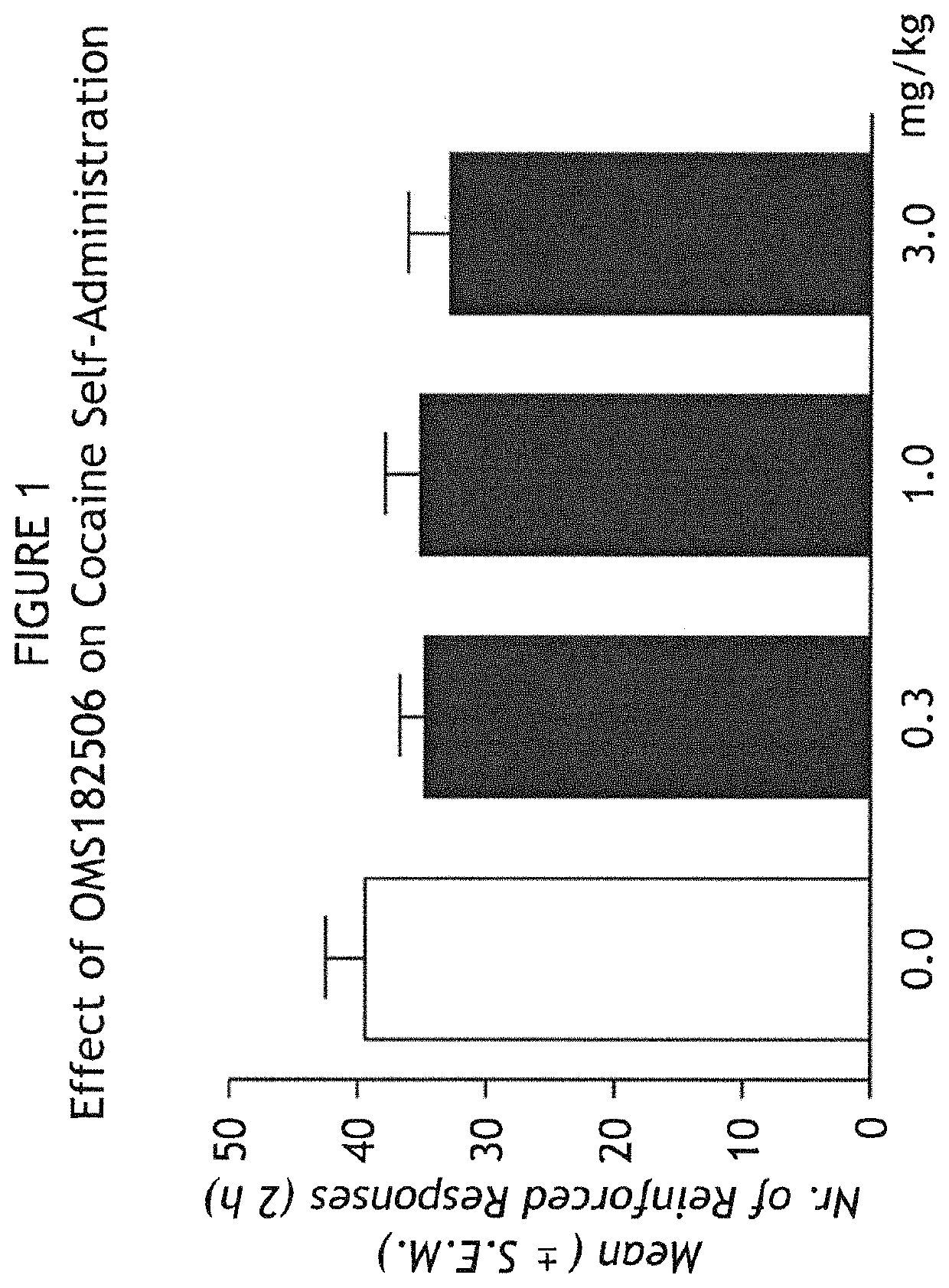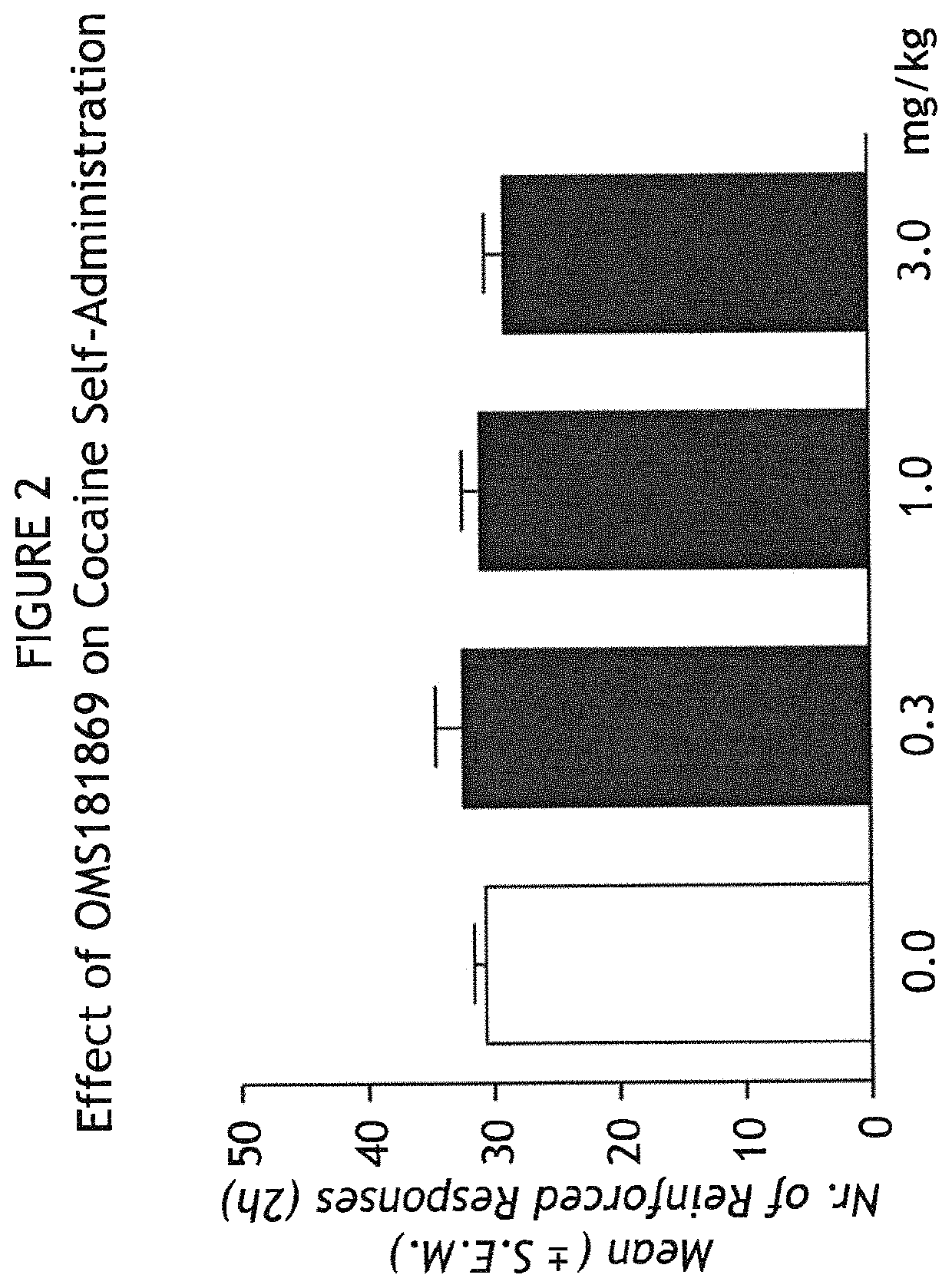Treatment of addiction and impulse-control disorders using PDE7 inhibitors
a technology of phosphodiesterase and inhibitors, applied in the direction of nervous disorders, heterocyclic compound active ingredients, drug compositions, etc., can solve the problems of alcohol abuse, affecting work performance, social problems and adverse consequences, and affecting work performance, so as to prevent relapse of addictive or compulsive behavior, and prevent relapse of addictive behavior
- Summary
- Abstract
- Description
- Claims
- Application Information
AI Technical Summary
Benefits of technology
Problems solved by technology
Method used
Image
Examples
example 1
bition Reduces Relapse to Cocaine Addiction and Reduces Chronic Cocaine Self-Administration
[1313]The ability of PDE7 inhibition to reduce cocaine use was demonstrated in a rat model of cocaine addiction. Cocaine hydrochloride (obtained from the National Institute on Drug Abuse, Bethesda, Md.) was dissolved in sterile physiological saline at a concentration of 0.25 mg / 0.1 ml. Drug or vehicle solution was infused at a volume of 0.1 ml over 4 s. Two PDE7 inhibitors in accordance with Formulas 1A (OMS182056) and 1B (OMS181869) herein above, were tested for effects on cocaine self-administration. PDE7 inhibitors were given orally (OS) via gavage procedure 12 hours and 1 hour before the beginning of cocaine self-administration.
[1314]Male Wistar rats weighing between 180 and 200 g at the time of arrival in the lab were used. The rats were housed in groups of three in a humidity- and temperature-controlled (22o C) vivarium on a 12 h: 12 h reverse light / dark cycle (on, 17:00; off, 05:00) wit...
example 2
bition Reduces Binge Eating in Response to Stress
[1327]Reinstatement of binge eating behavior has been obtained in experimental animals through a combination of repeated food restriction and stress. (Cifani et al, Psychopharmacology 204:113-125 (2009). For the present invention, stress-induced binge eating was tested as in Cifani. Rats were housed in individual cages and were given chow and water ad libitum for two weeks prior to the experiment. During the experiment, rats were given one of two food sources: standard rat food pellets or Highly Palatable Food (HPF); a mixture of 52% Nutella TM chocolate cream, 33% rat food pellets, and 15% water (5.33 kcal / g; 56%, 31%, and 7% from carbohydrate, fat, and protein, respectively).
[1328]Rats were divided into four groups. Individual groups were subjected to the following 8-day cycles, three consecutive times. Rats were given PDE7 or vehicle on day 25.
[1329](1) Control group—Non-restricted, non-stressed (NR+NS). Rats had chow ad libitum fo...
example 3
bition Alleviates Nicotine Addiction
[1336]The ability of PDE7 inhibition to reduce nicotine use was demonstrated in a rat model of nicotine addiction. Male Wistar rats weighing between 180 and 200 g at the time of arrival in the lab were used. The rats were housed in groups of three in a humidity- and temperature-controlled (22° C.) vivarium on a 12 h: 12 h reverse light / dark cycle (on, 17:00; off, 05:00) with ad libitum access to food and water.
[1337]Rats were surgically implanted with jugular catheters and allowed to recover for one week. The animals underwent daily two-hour (short access) or six-hour (long access) training sessions in which every three active lever presses triggered the delivery of 0.03 mg of nicotine. After achieving a stable rate of active lever pressing, the animals were injected i.p. with vehicle or drug (either OMS182401 or OMS182399, another PDE7 inhibitor in accordance with Formula 6 above) fifteen minutes before the test session. The measured read-out was...
PUM
 Login to View More
Login to View More Abstract
Description
Claims
Application Information
 Login to View More
Login to View More - R&D
- Intellectual Property
- Life Sciences
- Materials
- Tech Scout
- Unparalleled Data Quality
- Higher Quality Content
- 60% Fewer Hallucinations
Browse by: Latest US Patents, China's latest patents, Technical Efficacy Thesaurus, Application Domain, Technology Topic, Popular Technical Reports.
© 2025 PatSnap. All rights reserved.Legal|Privacy policy|Modern Slavery Act Transparency Statement|Sitemap|About US| Contact US: help@patsnap.com



